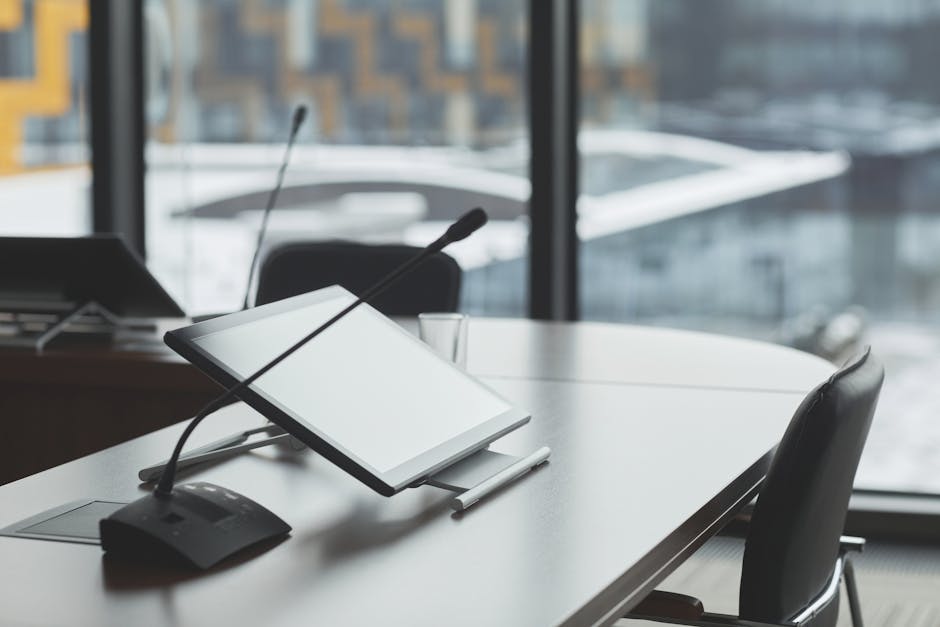The Ultimate Conference Room Setup Checklist: Essentials for Post-Pandemic Success
“As businesses adapt to the post-pandemic workplace, conference room setups require careful consideration. This comprehensive guide provides a checklist of essentials, from technology upgrades to safety measures, ensuring your meeting spaces foster collaboration while prioritizing employee well-being. ”

The Ultimate Conference Room Setup Checklist: Essentials for Post-Pandemic Success
In the wake of the COVID-19 pandemic, the way we approach office spaces, particularly conference rooms, has undergone a significant transformation. As organizations navigate the complexities of return-to-office guidelines, it's crucial to reimagine these collaborative spaces to ensure safety, efficiency, and productivity. This comprehensive checklist will guide you through the essential elements of a post-conference room setup, helping you create an environment that meets the evolving needs of your workforce.

1. Safety First: Implementing Physical Distancing Measures
The cornerstone of any post-pandemic conference room setup is ensuring the safety of its occupants. Here are key considerations:
- Capacity Limits: Clearly define and communicate the maximum number of attendees allowed in each room.
- Seating Arrangements: Rearrange chairs to maintain appropriate physical distance between participants.
- Visual Cues: Install floor markings or signage to guide proper distancing and traffic flow.
- Ventilation: Upgrade to MERV 13 filters and install temperature/humidity monitoring systems to improve air quality.
2. Technology Upgrades for Hybrid Collaboration
With the rise of hybrid work trends, conference rooms must be equipped to seamlessly connect in-person and remote participants:
- Video Conferencing Equipment: Invest in high-quality cameras, microphones, and speakers for clear communication.
- Large Displays: Install large screens or projectors to ensure remote participants are visible to everyone in the room.
- Digital Whiteboards: Implement solutions like Jamboard or Miro for collaborative brainstorming sessions.
- Touchless Technology: Introduce motion-sensor lighting and voice-activated controls to minimize surface contact.

3. Booking and Management Systems
Efficient use of conference rooms requires robust scheduling and management tools:
- Room Booking Software: Implement a user-friendly system for reserving spaces and checking availability.
- Digital Signage: Display room schedules, capacity limits, and cleaning status outside each conference room.
- Check-in Systems: Use mobile apps or QR codes for touchless check-ins to meetings.
4. Sanitization and Hygiene Protocols
Maintaining a clean environment is crucial for employee confidence and health:
- Cleaning Supplies: Provide easily accessible disinfectant wipes, hand sanitizer, and disposable masks in each room.
- Cleaning Schedule: Implement and display a rigorous cleaning routine between meetings.
- Air Purifiers: Consider adding portable air purifiers to supplement the HVAC system.
5. Furniture and Layout Considerations
The physical setup of your conference room plays a significant role in its functionality and safety:
- Flexible Furniture: Opt for easily movable chairs and tables to accommodate different meeting sizes and formats.
- Plexiglass Dividers: Install clear dividers where appropriate to provide additional protection without hindering communication.
- Storage Solutions: Provide designated areas for personal belongings to keep surfaces clear and easily cleanable.

6. Communication and Training
Ensure all employees are well-informed about the new conference room protocols:
- Usage Guidelines: Develop and distribute clear instructions on room usage, including capacity limits and cleaning responsibilities.
- Technology Training: Offer sessions to familiarize staff with new collaboration tools and equipment.
- Feedback Mechanism: Implement a system for employees to report issues or suggest improvements.
7. Amenities and Comfort
While prioritizing safety, don't forget about creating a comfortable and productive environment:
- Lighting: Ensure adequate, adjustable lighting to reduce eye strain during video calls.
- Acoustics: Consider sound-absorbing materials to improve audio quality for both in-person and remote participants.
- Ergonomics: Provide comfortable seating options for extended meetings.
By implementing this comprehensive checklist, you'll create conference rooms that not only meet the challenges of the post-pandemic workplace but also enhance collaboration and productivity. Remember, the key to success lies in infusing hospitality into workplace experience management, making employees feel safe, valued, and empowered to do their best work.
As you refine your conference room setup, consider how these changes align with your overall hybrid work policy. By creating flexible, safe, and technologically advanced meeting spaces, you'll be well-positioned to support the diverse needs of your workforce in the evolving landscape of modern work.